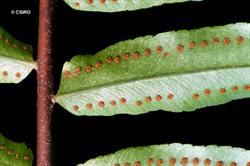Nephrolepidaceae
Australian Tropical Ferns and Lycophytes - Online edition
Nephrolepis obliterata





Nephrolepis obliterata (R.Br.) J.Sm.
Link to Australian Plant Name Index for publication details and synonyms: https://id.biodiversity.org.au/name/apni/82248
Sword Fern or Fishbone Fern
Stolons and basal portions of stipes scaly; scales lanceolate, red-brown, with pale margins (sparse except at growing node), with few to many short or long marginal cilia. Fronds to 1.75 m long; rachis usually glabrous, occasionally with scattered scales. Pinnae relatively widely-spaced, occasionally with a small rounded auricle. Sterile pinnae 20–160 mm long, 15–25 mm wide, usually glabrous; base often obliquely truncate; margins shallowly crenate; upper midrib occasionally with simple hairs; apex acute except in basal pinnae. Fertile pinnae 60–160 (–240) mm long, 5–15 (–20) mm wide; margins more deeply crenate. Sori submarginal; indusium reniform.
Occurs along the NE and E QLD coast from Torres Strait to Stradbroke Island. In NT it has been recorded from Wessel Islands. Also in Malesia and the Pacific Islands.
Terrestrial, lithophytic or occasionally epiphytic from logs and tree bases in rainforest, rainforest margins and open forests. This species forms extensive stands on vegetated rock-piles on Cape York.
A widely cultivated fern that can be invasive in garden and greenhouse situations.
Readily cultivated in a wide range of situations. Can be a weed.
Nephrolepis obliterata can be distinguished from other Australian Nephrolepis by the presence of sori near the pinnae margins, usually opening towards the margin.
Key to Australian Nephrolepis spp.:
1a. Sori linear with a linear indusium and borne on margin; pinnae with entire margins = Nephrolepis acutifolia
1b. Sori round or kidney-shaped with a kidney-shaped indusium and borne supramedially to medially, each on the end of a vein, margins ~ crenate = 2
2a. Pinnae with an obtuse apex, less than 50 mm long = 3
2b. Pinnae with an acute to attenuate apex, greater than 50 mm long = 4
3a. Rachis with scales, rarely hairy, basal auricles of pinnae overlapping rachis = Nephrolepis cordifolia
3b. Rachis with hairs, rarely scaley, basal auricles of pinnae not usually overlapping rachis = Nephrolepis arida
4a. Pinnae with an acroscopic basal auricle; all parts hirsute = 5
4b. Pinnae lacking a distinct acroscopic basal auricle, indumentum sparse = 5
5a. Hairs on upper side of costae absent; rachis scales rufous, with strongly dentate acumen; sori submarginal = Nephrolepis hirsutula
5b. Hairs on upper side of costa present; rachis scales hyaline or light brown (rarely rufous), with nearly entire acumen; sori submedial = Nephrolepis brownii
6a. Sori borne close to margin, stolons densely scaly = Nephrolepis biserrata
6b Sori borne medially, stolons green with few scales = Nephrolepis obliterata
Field AR, Quinn CJ, Zich FA (2022) Australian Tropical Ferns and Lycophytes. apps.lucidcentral.org/fern/text/intro/index.htm (accessed online INSERT DATE).
Field AR, Quinn CJ, Zich FA (2022) ‘Platycerium superbum’, in Australian Tropical Ferns and Lycophytes. apps.lucidcentral.org/fern/text/entities/platycerium_superbum.htm (accessed online INSERT DATE).







